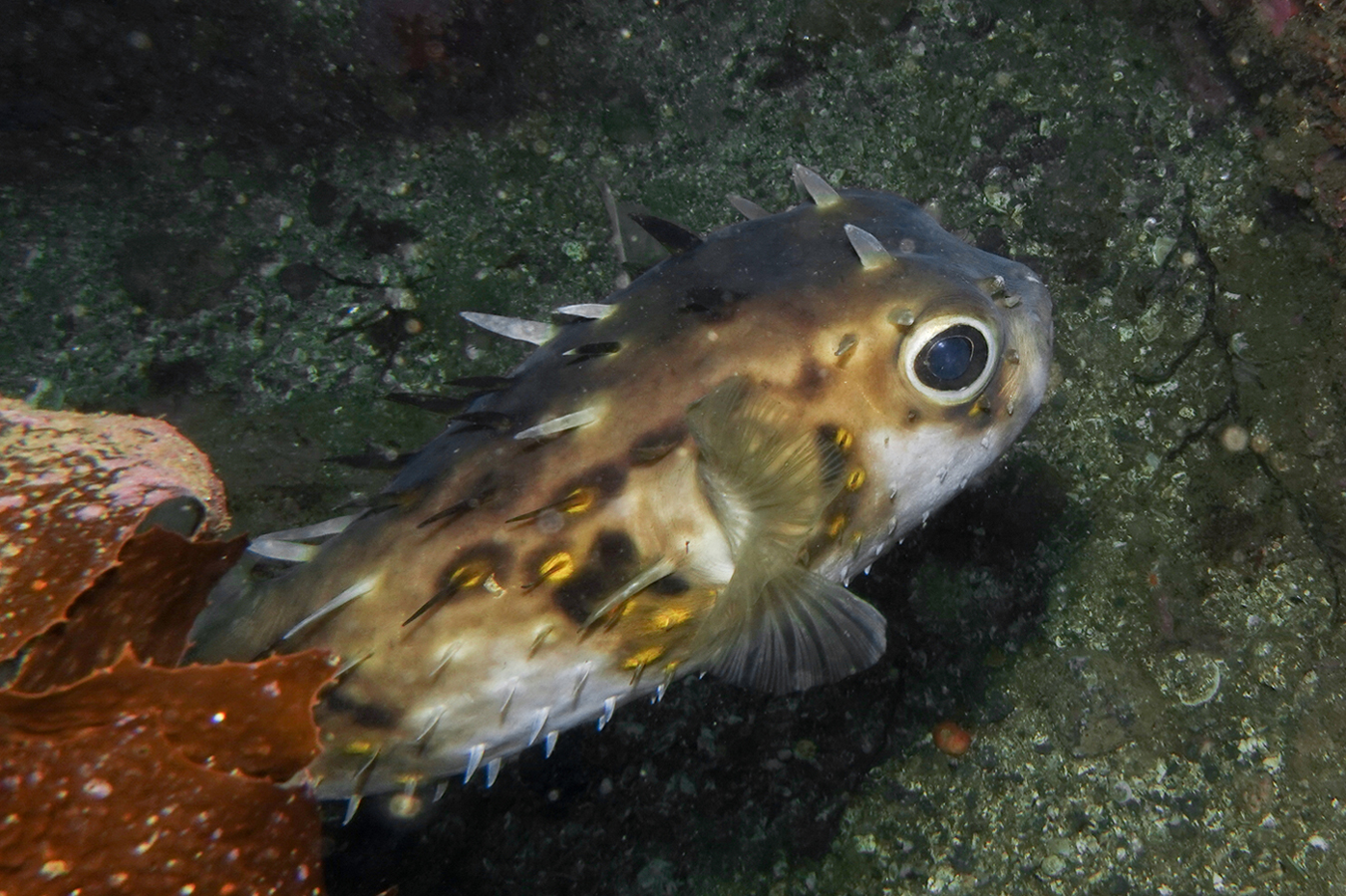Australian Burrfish, Allomycterus pilatus Whitley 1931

An Australian Burrfish, Allomycterus pilatus, in the Bay of Islands, Northland, New Zealand, September 2020. Source: lcolmer / iNaturalist.org. License: CC By Attribution-NonCommercial
A robust pale olive-grey porcupinefish with a white belly, an olive and yellow blotch behind the eye and one below the dorsal-fin origin, and a blackish blotch behind the pectoral fin surrounded by spines with yellow bases. The body spines are short, robust and immovable.
Two forms are recognised: a shallow-water form with dark spots scattered on the back, and a deep-water form with yellow blotches on the sides.
Australian Burrfish, Allomycterus pilatus Whitley 1931
More Info
|
Distribution |
Widespread in temperate waters of the southern half of Australia, from off Bustard Head Lighthouse, Queensland, to Rottnest Island, Western Australia, including around Tasmania. Elsewhere, the species occurs on seamounts off south-eastern Australia, on the Lord Howe Rise and the Norfolk Ridge in the Tasman Sea. Elsewhere the species occurs in New Zealand. Although Australian Burrfish usually occur in deeper waters over the continental shelf, individuals occasionally enter coastal estuaries. They usually inhabit rocky reefs and weedy areas, mostly near the bottom in moderately shallow to deeper waters, but sometimes schooling in surface waters, in depths of 5-320 m. |
|
Features |
Dorsal fin 16-18; Anal fin 15-16; Caudal fin 9; Pectoral fin 19-21. Body deep (38-55% SL deflated), moderately short, circular in cross section, capable of being inflated into sphere; caudal peduncle very shallow, rather short. Head large (38-40% SL), snout short; eyes large (22-29% HL); mouth broad (length to corner 17-20% HL); teeth fused into beak like jaws, no seam separating right and left halves; gill opening on each side confined to short vertical slit immediately before pectoral fin base. Scales and lateral line absent; body mostly covered with prominent, but short fixed spines, each with three, tripod like roots; most spines shorter than eye diameter; elongate erectile spine behind each pectoral fin, and several slightly longer fixed spines somewhat posteriorly on back and sides; no spines wholly on caudal peduncle; area above and immediately in front of gill openings with small fixed spines. Single lobe-like opposing dorsal and anal fins, each with short base, overhanging caudal peduncle; caudal fin rounded. Pectoral fins large, shallow notch in hind margin. Pelvic fins absent. Body robust, oval, covered in short, fixed, blade-like spines, each with a tripod-like base; an elongate erectile spine behind pectoral fin; no spines wholly on tail base; most spines shorter than eye diameter; dorsal fin with truncate hind margin, anal fin rounded, pectoral fin with shallow notch in hind margin. |
|
Size |
To 50 cm TL. |
|
Colour |
Olive-grey above, white below; olive and yellow blotch between each eye and gill opening; blackish blotch on side behind each pectoral fin, spines encircling blotch with yellow bases; olive and yellow blotch on middle of side below dorsal fin origin. Deeper-water individuals may have yellow markings. |
|
Feeding |
Usually feeds on bottom-living hard-shelled invertebrates. |
|
Biology |
Females spawn pelagic eggs and the larvae pass through a pelagic juvenile phase. |
|
Fisheries |
Although of no interest to fisheries, the species is occasionally taken in commercial trawls. |
|
Conservation |
|
|
Etymology |
The specific name is from the Latin pilatus (= armed with javelins), in reference to the spines on the body of this species. |
|
Species Citation |
Allomycterus pilatus Whitley 1931, Rec. Aust. Mus. 18(3): 125. Type locality: Botany Bay, New South Wales (based on specimens of Allomycterus jaculiferus in McCulloch 1921:141). |
|
Author |
Bray, D.J. 2021 |
|
Resources |








